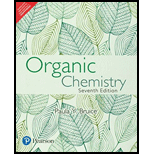
Concept explainers
a)
Interpretation:
The synthesis of the given compound from benzene has to be shown
Concept Introduction:
b)
Interpretation:
The synthesis of the given compound from benzene has to be shown
Concept Introduction:
Aromatic compounds such as benzene which has closed ring and alternate double bonds undergo electrophilic aromatic substitution reactions. Electrophilic aromatic substitution takes place when an electrophile displaces a hydrogen atom of an aromatic ring. There are five most common electrophilic aromatic substitution reactions that are halogenation, nitration, sulfonation, Friedel-Crafts acylation and Friedel-Crafts alkylation. All these reactions take place by same two-step mechanism.
c)
Interpretation:
The synthesis of the given compound from benzene has to be shown
Concept Introduction:
Aromatic compounds such as benzene which has closed ring and alternate double bonds undergo electrophilic aromatic substitution reactions. Electrophilic aromatic substitution takes place when an electrophile displaces a hydrogen atom of an aromatic ring. There are five most common electrophilic aromatic substitution reactions that are halogenation, nitration, sulfonation, Friedel-Crafts acylation and Friedel-Crafts alkylation. All these reactions take place by same two-step mechanism.
d)
Interpretation:
The synthesis of the given compound from benzene has to be shown
Concept Introduction:
Aromatic compounds such as benzene which has closed ring and alternate double bonds undergo electrophilic aromatic substitution reactions. Electrophilic aromatic substitution takes place when an electrophile displaces a hydrogen atom of an aromatic ring. There are five most common electrophilic aromatic substitution reactions that are halogenation, nitration, sulfonation, Friedel-Crafts acylation and Friedel-Crafts alkylation. All these reactions take place by same two-step mechanism.
Want to see the full answer?
Check out a sample textbook solution
Chapter 19 Solutions
Organic Chemistry - MasteringChemistry
- When synthesizing acetals and ketals, what is the main driving force behind whether the reaction favors the carbonyl species or the acetal/ketal? a the catalytic acid b solvent c temperature d Le Châtelier's Principlearrow_forwardThe reaction of a nitrile with an alcohol in the presence of a strong acid forms an N-substituted amide. This reaction, known as the Ritter reaction, doesnot work with primary alcohols. a. Why does the Ritter reaction not work with primary alcohols? b. Provide an explanation for why an amide is less susceptible to nucleophilic attack than its corresponding ester.arrow_forwardWrite the equation for the reaction of the following with acetaldehyde: a. 2,4-DNP b. Schiff's reagant c. Tollen's reagent d. Fehling's solution e. Acidified KMnO4arrow_forward
- Explain why the treatment of anisole with HBr yields phenol and CH3Br, but not bromobenzene.arrow_forward(A)Complete reaction between benzil and sodium borohydride to from benzoin b) complete reaction below between benzil and sodium borohydride to from hydrobenzoinarrow_forwardConvert Compound A to Compound B by coming up with a route for this. Design a route to take A to B be sure to outline the reagents for each step. Use reactions only from organic chemistry 1arrow_forward
- What product(s) result from nitration of each of the following? a. propylbenzene c. benzaldehyde e. benzenesulfonic acid b. bromobenzene d. benzonitrile f. cyclohexylbenzenearrow_forwardWhy is it not advisable to use aqueous hydrochloric acid in a Grignard reaction of a ketone? A) The Grignard reagent will react with the acid and cannot react with the ketone. B) The ketone will be protonated and will become unreactive. C) The ketone will form an unreactive enol. D) The Grignard reagent won't dissolve in aqueous solutionsarrow_forwardFischer esterification cannot be used to prepare tert-butyl esters. Instead, carboxylic acids are treated with 2-methyIpropene in the presence of an acid catalyst to generate them. REFER IMAGE (a) Why does the Fischer esterification fail for the synthesis of tert-butyl esters?(b) Propose a mechanism for the 2-methylpropene method.arrow_forward
- Explain Reaction of Grignard Reagents with Carbon Dioxide ?arrow_forwardHow do you explain the difference in colors between the hydrazone product formed from simple aldehyde/ketone and aromatic aldehyde/ketone (yellow vs orange) in Dinitrophenylhydrazine Test?arrow_forwardWrite a) Hunsdiecker reaction b) Fittig rection c) Sandmeyer reaction d) Fridel craft acylation e) Wurtz reactionarrow_forward
 Organic ChemistryChemistryISBN:9781305580350Author:William H. Brown, Brent L. Iverson, Eric Anslyn, Christopher S. FootePublisher:Cengage Learning
Organic ChemistryChemistryISBN:9781305580350Author:William H. Brown, Brent L. Iverson, Eric Anslyn, Christopher S. FootePublisher:Cengage Learning Organic Chemistry: A Guided InquiryChemistryISBN:9780618974122Author:Andrei StraumanisPublisher:Cengage Learning
Organic Chemistry: A Guided InquiryChemistryISBN:9780618974122Author:Andrei StraumanisPublisher:Cengage Learning

